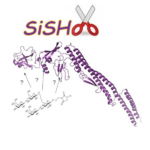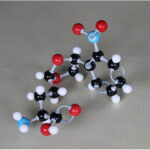
Emilie CAMBERLEIN
Maître de conférences Université
section 62
| Équipe : |
Thèmes de recherche
Développement de glycoconjugués utilisant des acides aminés non naturels pour des applications vaccinales contre Streptococcus pneumoniae et Vibrio cholerae et pour l’étude de l’O-GlcNacylation des protéines.
Projets
Parcours universitaire
Depuis 2012 : Maître de Conférences en Biochimie, UFR Sciences et Techniques (Université de Nantes) et laboratoire UFIP UMR CNRS 6286 : « Unité Fonctionnalité et Ingénierie des protéines ».
2010-2012 : ATER Biochimie Faculté des Sciences Pharmaceutiques et Biologiques (Université de Rennes 1) et Laboratoire INSERM U835 EA2311: « Fonction, structure et inactivation d’ARN bactériens ».
2008-2010 : Post-doctorat Centre for Respiratory Research, University College London (Londres, Royaume Uni).
2008 (4 mois) : Assistante de recherche Laboratoire de Microbiologie unité EA-1254 (Université de Rennes 1).
2004-2007 : Thèse de doctorat, laboratoire INSERM U522: Régulation des équilibres fonctionnels du foie normal et pathologique (Université de Rennes 1).
Publications
2 publications
Prasanna, Maruthi; Calvino, Rubén Varela; Lambert, Annie; Romero, Maria Arista; Pujals, Sylvia; Trottein, François; Camberlein, Emilie; Grandjean, Cyrille; Csaba, Noemi
Semisynthetic Pneumococcal Glycoconjugate Nanovaccine Article de journal
Dans: Bioconjugate Chemistry, vol. 34, no. 9, p. 1563–1575, 2023, ISSN: 1043-1802, (Publisher: American Chemical Society).
@article{prasanna_semisynthetic_2023,
title = {Semisynthetic Pneumococcal Glycoconjugate Nanovaccine},
author = {Maruthi Prasanna and Rubén Varela Calvino and Annie Lambert and Maria Arista Romero and Sylvia Pujals and François Trottein and Emilie Camberlein and Cyrille Grandjean and Noemi Csaba},
url = {https://doi.org/10.1021/acs.bioconjchem.3c00252
hal-04209406v1 },
doi = {10.1021/acs.bioconjchem.3c00252},
issn = {1043-1802},
year = {2023},
date = {2023-09-01},
urldate = {2023-09-01},
journal = {Bioconjugate Chemistry},
volume = {34},
number = {9},
pages = {1563--1575},
abstract = {Pneumococcal conjugate vaccines offer an excellent safety profile and high protection against the serotypes comprised in the vaccine. However, inclusion of protein antigens fromStreptococcus pneumoniaecombined with potent adjuvants and a suitable delivery system are expected to both extend protection to serotype strains not represented in the formulation and stimulate a broader immune response, thus more effective in young children, elderly, and immunocompromised populations. Along this line, nanoparticle (NP) delivery systems can enhance the immunogenicity of antigens by protecting them from degradation and increasing their uptake by antigen-presenting cells, as well as offering co-delivery with adjuvants. We report herein the encapsulation of a semisynthetic glycoconjugate (GC) composed of a synthetic tetrasaccharide mimicking theS. pneumoniae serotype 14 capsular polysaccharide (CP14) linked to the Pneumococcal surface protein A (PsaA) using chitosan NPs (CNPs). These GC-loaded chitosan nanoparticles (GC-CNPs) were not toxic to human monocyte-derived dendritic cells (MoDCs), showed enhanced uptake, and displayed better immunostimulatory properties in comparison to the naked GC. A comparative study was carried out in mice to evaluate the immune response elicited by the glycoconjugate-administered subcutaneously (SC), where the GC-CNPs displayed 100-fold higher IgG response as compared with the group treated with nonencapsulated GC. Overall, the study demonstrates the potential of this chitosan-based nanovaccine for efficient delivery of glycoconjugate antigens.},
note = {Publisher: American Chemical Society},
keywords = {},
pubstate = {published},
tppubtype = {article}
}
Violo, Typhaine; Lambert, Annie; Pillot, Aline; Fanuel, Mathieu; Mac-Béar, Jessica; Broussard, Cédric; Grandjean, Cyrille; Camberlein, Emilie
Site-Selective Unnatural Amino Acid Incorporation at Single or Multiple Positions to Control Sugar-Protein Connectivity in Glycoconjugate Vaccine Candidates Article de journal
Dans: Chemistry--A European Journal, vol. 29, no. 15, p. e202203497, 2023, ISBN: 1521-3765.
@article{violo2023site,
title = {Site-Selective Unnatural Amino Acid Incorporation at Single or Multiple Positions to Control Sugar-Protein Connectivity in Glycoconjugate Vaccine Candidates},
author = {Typhaine Violo and Annie Lambert and Aline Pillot and Mathieu Fanuel and Jessica Mac-Béar and Cédric Broussard and Cyrille Grandjean and Emilie Camberlein},
url = {https://chemistry-europe.onlinelibrary.wiley.com/doi/full/10.1002/chem.202203497
hal-03918892v2
},
doi = {10.1002/chem.202203497},
isbn = {1521-3765},
year = {2023},
date = {2023-03-13},
urldate = {2023-03-13},
journal = {Chemistry--A European Journal},
volume = {29},
number = {15},
pages = {e202203497},
publisher = {Wiley Online Library},
abstract = {In cellulo site-specific unnatural amino acid incorporation based on amber stop codon reassignment is a powerful tool to modify proteins at defined positions. This technique is herein applied to the selective functionalization of the Pneumococcal surface adhesin A protein at three distinct positions. Nϵ-propargyloxycarbonyl-l-lysine residues were incorporated and their alkyne groups reacted using click-chemistry with a synthetic azido-functionalized tetrasaccharide representative of one repeat unit of the Streptococcus pneumoniae serotype 14 capsular polysaccharide. Anti-PsaA antibody response induced in mice by the trivalent glycoconjugate was determined in comparison with corresponding monovalent and randomly functionalized conjugates. Our results suggest that controlled was superior to random conjugation for preserving antigenicity. In definitive, the reported strategy offers a unique opportunity to study the impact of carbohydrate antigen-carrier protein connectivity on immunogenicity.},
keywords = {},
pubstate = {published},
tppubtype = {article}
}
1 publication
Prasanna, Maruthi; Podsiadla-Bialoskorska, Malgorzata; Mielecki, Damian; Ruffier, Nicolas; Fateh, Amina; Lambert, Annie; Fanuel, Mathieu; Camberlein, Emilie; Szolajska, Ewa; Grandjean, Cyrille
On the use of adenovirus dodecahedron as a carrier for glycoconjugate vaccines Article de journal
Dans: Glycoconjugate Journal, 2021, ISSN: 1573-4986.
@article{prasanna_use_2021,
title = {On the use of adenovirus dodecahedron as a carrier for glycoconjugate vaccines},
author = {Maruthi Prasanna and Malgorzata Podsiadla-Bialoskorska and Damian Mielecki and Nicolas Ruffier and Amina Fateh and Annie Lambert and Mathieu Fanuel and Emilie Camberlein and Ewa Szolajska and Cyrille Grandjean},
url = {https://doi.org/10.1007/s10719-021-09999-3},
doi = {10.1007/s10719-021-09999-3},
issn = {1573-4986},
year = {2021},
date = {2021-01-01},
urldate = {2021-06-16},
journal = {Glycoconjugate Journal},
abstract = {Virus-Like Particles (VLPs) have been used as immunogenic molecules in numerous recombinant vaccines. VLPs can also serve as vaccine platform to exogenous antigens, usually peptides incorporated within the protein sequences which compose the VLPs or conjugated to them. We herein described the conjugation of a synthetic tetrasaccharide mimicking the Streptococcus pneumoniae serotype 14 capsular polysaccharide to recombinant adenoviral type 3 dodecahedron, formed by the self-assembling of twelve penton bases and investigated the induced immune response when administered subcutaneously (s.c.). Whether formulated in the form of a dodecahedron or disassembled, the glycoconjugate induced an anti-protein response after two and three immunizations equivalent to that observed when the native dodecahedron was administered. On the other hand, the glycoconjugate induced a weak anti-IgM response which diminishes after two doses but no IgM-to-IgG switch was observed in mice against the serotype 14 capsular polysaccharide. In definitive, the whole conjugation process preserved both particulate nature and immunogenicity of the adenoviral dodecahedron. Further studies are needed to fully exploit adenoviral dodecahedron potential in terms of plasticity towards sequence engineering and of its capacity to stimulate the immune system via the intranasal route of administration as well as to shift the response to the carbohydrate antigen by playing both with the carbohydrate to protein ratio and the length of the synthetic carbohydrate antigen.},
keywords = {},
pubstate = {published},
tppubtype = {article}
}
1 publication
Violo, Typhaine; Dussouy, Christophe; Tellier, Charles; Grandjean, Cyrille; Camberlein, Emilie
Homogenous Glycoconjugate Produced by Combined Unnatural Amino Acid Incorporation and Click-Chemistry for Vaccine Purposes Article de journal
Dans: Journal of visualized experiments : JoVE, 2020.
@article{violo:hal-02990572,
title = {Homogenous Glycoconjugate Produced by Combined Unnatural Amino Acid Incorporation and Click-Chemistry for Vaccine Purposes},
author = {Typhaine Violo and Christophe Dussouy and Charles Tellier and Cyrille Grandjean and Emilie Camberlein},
url = {https://hal.archives-ouvertes.fr/hal-02990572},
doi = {10.3791/60821},
year = {2020},
date = {2020-01-01},
journal = {Journal of visualized experiments : JoVE},
publisher = {JoVE},
keywords = {},
pubstate = {published},
tppubtype = {article}
}
2 publications
Pillot, Aline; Defontaine, Alain; Fateh, Amina; Lambert, Annie; Prasanna, Maruthi; Fanuel, Mathieu; Pipelier, Muriel; Csaba, Noemi; Violo, Typhaine; Camberlein, Emilie; Grandjean, Cyrille
Site-Specific Conjugation for Fully Controlled Glycoconjugate Vaccine Preparation Article de journal
Dans: Frontiers in Chemistry, vol. 7, no. November, p. 1–9, 2019, ISSN: 22962646.
@article{Pillot2019,
title = {Site-Specific Conjugation for Fully Controlled Glycoconjugate Vaccine Preparation},
author = {Aline Pillot and Alain Defontaine and Amina Fateh and Annie Lambert and Maruthi Prasanna and Mathieu Fanuel and Muriel Pipelier and Noemi Csaba and Typhaine Violo and Emilie Camberlein and Cyrille Grandjean},
doi = {10.3389/fchem.2019.00726},
issn = {22962646},
year = {2019},
date = {2019-01-01},
journal = {Frontiers in Chemistry},
volume = {7},
number = {November},
pages = {1--9},
abstract = {Glycoconjugate vaccines are formed by covalently link a carbohydrate antigen to a carrier protein whose role is to achieve a long lasting immune response directed against the carbohydrate antigen. The nature of the sugar antigen, its length, its ratio per carrier protein and the conjugation chemistry impact on both structure and the immune response of a glycoconjugate vaccine. In addition it has long been assumed that the sites at which the carbohydrate antigen is attached can also have an impact. These important issue can now be addressed owing to the development of novel chemoselective ligation reactions as well as techniques such as site-selective mutagenesis, glycoengineering, or extension of the genetic code. The preparation and characterization of homogeneous bivalent pneumococcal vaccines is reported. The preparation and characterization of homogeneous bivalent pneumococcal vaccines is reported. A synthetic tetrasaccharide representative of the serotype 14 capsular polysaccharide of Streptococcus pneumoniae has been linked using the thiol/maleimide coupling chemistry to four different Pneumococcal surface adhesin A (PsaA) mutants, each harboring a single cysteine mutation at a defined position. Humoral response of these 1 to 1 carbohydrate antigen/PsaA conjugates have been assessed in mice. Our results showed that the carbohydrate antigen-PsaA connectivity impacts the anti-carrier response and raise questions about the design of glycoconjugate vaccine whereby the protein plays the dual role of immunogen and carrier.},
keywords = {},
pubstate = {published},
tppubtype = {article}
}
Prasanna, Maruthi; Soulard, Daphnée; Camberlein, Emilie; Ruffier, Nicolas; Lambert, Annie; Trottein, François; Csaba, Noemi; Grandjean, Cyrille
Semisynthetic glycoconjugate based on dual role protein/PsaA as a pneumococcal vaccine Article de journal
Dans: European Journal of Pharmaceutical Sciences, vol. 129, p. 31–41, 2019, ISSN: 0928-0987.
@article{PRASANNA201931,
title = {Semisynthetic glycoconjugate based on dual role protein/PsaA as a pneumococcal vaccine},
author = {Maruthi Prasanna and Daphnée Soulard and Emilie Camberlein and Nicolas Ruffier and Annie Lambert and François Trottein and Noemi Csaba and Cyrille Grandjean},
url = {http://www.sciencedirect.com/science/article/pii/S0928098718305487},
doi = {https://doi.org/10.1016/j.ejps.2018.12.013},
issn = {0928-0987},
year = {2019},
date = {2019-01-01},
journal = {European Journal of Pharmaceutical Sciences},
volume = {129},
pages = {31--41},
abstract = {Pneumococcal infections remain a major public health concern worldwide. The currently available vaccines in the market are based on pneumococcal capsular polysaccharides but they still need to be improved to secure an optimal coverage notably in population at risk. To circumvent this, association of virulence pneumococcal proteins to the polysaccharide valencies has been proposed with the hope to observe an additive - if not synergistic - protective effect. Along this line, the use of the highly conserved and ubiquitous pneumococcal surface adhesin A (PsaA) as a protein carrier for a synthetic pneumococcal oligosaccharide is demonstrated herein for the first time. A tetrasaccharide mimicking functional antigenic determinants from the S. pneumoniae serotype 14 capsular polysaccharide (Pn14TS) was chemically synthesised. The mature PsaA (mPsaA) was expressed in E. coli and purified using affinity chromatography. The Pn14PS was conjugated to mPsaA using maleimide-thiol coupling chemistry to obtain mPsaA-Pn14PS conjugate (protein/sugar molar ratio: 1/5.4). The mPsaA retained the structural conformation after the conjugation and lyophilisation. The prepared glycoconjugate adjuvanted with α-galactosylceramide, a potent activator of invariant Natural Killer T cells, was tested in mice for its immunological response upon subcutaneous injection in comparison with mPsaA alone and a model BSA conjugate (BSA-Pn14PS, used here as a control). Mice immunised with the mPsaA-Pn14TS produced a robust IgG response against mPsaA and against the capsular polysaccharide from pneumococcal serotype 14. These data provide the basis for novel pneumococcal vaccine development.},
keywords = {},
pubstate = {published},
tppubtype = {article}
}
2019
Periselneris, Jimstan; Ercoli, Giuseppe; Pollard, Tracey; Chimalapati, Suneeta; Camberlein, Emilie; Szylar, Gabriella; Hyams, Catherine; Tomlinson, Gillian; Petersen, Fernanda C; Floto, Andres R; Noursadeghi, Mahdad; Brown, Jeremy S
Relative Contributions of Extracellular and Internalized Bacteria to Early Macrophage Proinflammatory Responses to Streptococcus pneumoniae Article de journal
Dans: mBio, vol. 10, no. 5, 2019.
@article{EQ2:CAMBERLEIN:2019,
title = {Relative Contributions of Extracellular and Internalized Bacteria to Early Macrophage Proinflammatory Responses to Streptococcus pneumoniae},
author = {Jimstan Periselneris and Giuseppe Ercoli and Tracey Pollard and Suneeta Chimalapati and Emilie Camberlein and Gabriella Szylar and Catherine Hyams and Gillian Tomlinson and Fernanda C Petersen and Andres R Floto and Mahdad Noursadeghi and Jeremy S Brown},
editor = {Liise-anne Pirofski and Larry S McDaniel},
url = {https://mbio.asm.org/content/10/5/e02144-19},
doi = {10.1128/mBio.02144-19},
year = {2019},
date = {2019-01-01},
journal = {mBio},
volume = {10},
number = {5},
publisher = {American Society for Microbiology},
abstract = {Both intracellular immune sensing and extracellular innate immune sensing have been implicated in initiating macrophage proinflammatory cytokine responses to Streptococcus pneumoniae. The S. pneumoniae capsule, a major virulence determinant, prevents phagocytosis, and we hypothesized that this would reduce activation of host innate inflammatory responses by preventing activation of intracellular proinflammatory signaling pathways. We investigated this hypothesis in human monocyte-derived macrophages stimulated with encapsulated or isogenic unencapsulated mutant S. pneumoniae. Unexpectedly, despite strongly inhibiting bacterial internalization, the capsule resulted in enhanced inflammatory cytokine production by macrophages infected with S. pneumoniae. Experiments using purified capsule material and a Streptococcus mitis mutant expressing an S. pneumoniae serotype 4 capsule indicated these differences required whole bacteria and were not due to proinflammatory effects of the capsule itself. Transcriptional profiling demonstrated relatively few differences in macrophage gene expression profiles between infections with encapsulated S. pneumoniae and those with unencapsulated S. pneumoniae, largely limited to reduced expression of proinflammatory genes in response to unencapsulated bacteria, predicted to be due to reduced activation of the NF-κB family of transcription factors. Blocking S. pneumoniae internalization using cytochalasin D had minimal effects on the inflammatory response to S. pneumoniae. Experiments using murine macrophages indicated that the affected genes were dependent on Toll-like receptor 2 (TLR2) activation, although not through direct stimulation of TLR2 by capsule polysaccharide. Our data demonstrate that the early macrophage proinflammatory response to S. pneumoniae is mainly dependent on extracellular bacteria and reveal an unexpected proinflammatory effect of encapsulated S. pneumoniae that could contribute to disease pathogenesis.IMPORTANCE Multiple extra- and intracellular innate immune receptors have been identified that recognize Streptococcus pneumoniae, but the relative contributions of intra- versus extracellular bacteria to the inflammatory response were unknown. We have shown that intracellular S. pneumoniae contributes surprisingly little to the inflammatory responses, with production of important proinflammatory cytokines largely dependent on extracellular bacteria. Furthermore, although we expected the S. pneumoniae polysaccharide capsule to block activation of the host immune system by reducing bacterial internalization and therefore activation of intracellular innate immune receptors, there was an increased inflammatory response to encapsulated compared to unencapsulated bacteria, which is likely to contribute to disease pathogenesis.},
keywords = {},
pubstate = {published},
tppubtype = {article}
}
2018
Germain-Amiot, Noëlla; Augagneur, Yoann; Camberlein, Emilie; Nicolas, Irène; Lecureur, Valérie; Rouillon, Astrid; Felden, Brice
A novel Staphylococcus aureus cis-trans type I toxin-antitoxin module with dual effects on bacteria and host cells Article de journal
Dans: Nucleic Acids Research, vol. 47, no. 4, p. 1759-1773, 2018, ISSN: 0305-1048.
@article{EQ2:CAMBERLEIN:2018,
title = {A novel Staphylococcus aureus cis-trans type I toxin-antitoxin module with dual effects on bacteria and host cells},
author = {Noëlla Germain-Amiot and Yoann Augagneur and Emilie Camberlein and Irène Nicolas and Valérie Lecureur and Astrid Rouillon and Brice Felden},
url = {https://doi.org/10.1093/nar/gky1257},
doi = {10.1093/nar/gky1257},
issn = {0305-1048},
year = {2018},
date = {2018-01-01},
journal = {Nucleic Acids Research},
volume = {47},
number = {4},
pages = {1759-1773},
abstract = {Bacterial type I toxin^a€``antitoxin (TA) systems are widespread, and consist of a stable toxic peptide whose expression is monitored by a labile RNA antitoxin. We characterized Staphylococcus aureus SprA2/SprA2AS module, which shares nucleotide similarities with the SprA1/SprA1AS TA system. We demonstrated that SprA2/SprA2AS encodes a functional type I TA system, with the cis-encoded SprA2AS antitoxin acting in trans to prevent ribosomal loading onto SprA2 RNA. We proved that both TA systems are distinct, with no cross-regulation between the antitoxins in vitro or in vivo. SprA2 expresses PepA2, a toxic peptide which internally triggers bacterial death. Conversely, although PepA2 does not affect bacteria when it is present in the extracellular medium, it is highly toxic to other host cells such as polymorphonuclear neutrophils and erythrocytes. Finally, we showed that SprA2AS expression is lowered during osmotic shock and stringent response, which indicates that the system responds to specific triggers. Therefore, the SprA2/SprA2AS module is not redundant with SprA1/SprA1AS, and its PepA2 peptide exhibits an original dual mode of action against bacteria and host cells. This suggests an altruistic behavior for S.^A aureus in which clones producing PepA2 in vivo shall die as they induce cytotoxicity, thereby promoting the success of the community.},
keywords = {},
pubstate = {published},
tppubtype = {article}
}
Germain-Amiot, Noëlla; Augagneur, Yoann; Camberlein, Emilie; Nicolas, Irène; Lecureur, Valérie; Rouillon, Astrid; Felden, Brice
A novel Staphylococcus aureus cis–trans type I toxin–antitoxin module with dual effects on bacteria and host cells Article de journal
Dans: Nucleic Acids Research, vol. 47, no. 4, p. 1759-1773, 2018, ISSN: 0305-1048.
@article{10.1093/nar/gky1257,
title = {A novel Staphylococcus aureus cis–trans type I toxin–antitoxin module with dual effects on bacteria and host cells},
author = {Noëlla Germain-Amiot and Yoann Augagneur and Emilie Camberlein and Irène Nicolas and Valérie Lecureur and Astrid Rouillon and Brice Felden},
url = {https://doi.org/10.1093/nar/gky1257},
doi = {10.1093/nar/gky1257},
issn = {0305-1048},
year = {2018},
date = {2018-01-01},
journal = {Nucleic Acids Research},
volume = {47},
number = {4},
pages = {1759-1773},
abstract = {Bacterial type I toxin–antitoxin (TA) systems are widespread, and consist of a stable toxic peptide whose expression is monitored by a labile RNA antitoxin. We characterized Staphylococcus aureus SprA2/SprA2AS module, which shares nucleotide similarities with the SprA1/SprA1AS TA system. We demonstrated that SprA2/SprA2AS encodes a functional type I TA system, with the cis-encoded SprA2AS antitoxin acting in trans to prevent ribosomal loading onto SprA2 RNA. We proved that both TA systems are distinct, with no cross-regulation between the antitoxins in vitro or in vivo. SprA2 expresses PepA2, a toxic peptide which internally triggers bacterial death. Conversely, although PepA2 does not affect bacteria when it is present in the extracellular medium, it is highly toxic to other host cells such as polymorphonuclear neutrophils and erythrocytes. Finally, we showed that SprA2AS expression is lowered during osmotic shock and stringent response, which indicates that the system responds to specific triggers. Therefore, the SprA2/SprA2AS module is not redundant with SprA1/SprA1AS, and its PepA2 peptide exhibits an original dual mode of action against bacteria and host cells. This suggests an altruistic behavior for S. aureus in which clones producing PepA2 in vivo shall die as they induce cytotoxicity, thereby promoting the success of the community.},
keywords = {},
pubstate = {published},
tppubtype = {article}
}
2015
Camberlein, Emilie; Cohen, Jonathan M; José, Ricardo; Hyams, Catherine J; Callard, Robin; Chimalapati, Suneeta; Yuste, Jose; Edwards, Lindsey A; Marshall, Helina; van Rooijen, Nico; Noursadeghi, Mahdad; Brown, Jeremy S
Importance of Bacterial Replication and Alveolar Macrophage-Independent Clearance Mechanisms during Early Lung Infection with Streptococcus pneumoniae Article de journal
Dans: Infection and Immunity, vol. 83, no. 3, p. 1181–1189, 2015, ISSN: 0019-9567.
@article{EQ2:CAMBERLEIN:2015,
title = {Importance of Bacterial Replication and Alveolar Macrophage-Independent Clearance Mechanisms during Early Lung Infection with Streptococcus pneumoniae},
author = {Emilie Camberlein and Jonathan M Cohen and Ricardo José and Catherine J Hyams and Robin Callard and Suneeta Chimalapati and Jose Yuste and Lindsey A Edwards and Helina Marshall and Nico van Rooijen and Mahdad Noursadeghi and Jeremy S Brown},
editor = {A Camilli},
url = {https://iai.asm.org/content/83/3/1181},
doi = {10.1128/IAI.02788-14},
issn = {0019-9567},
year = {2015},
date = {2015-01-01},
journal = {Infection and Immunity},
volume = {83},
number = {3},
pages = {1181--1189},
publisher = {American Society for Microbiology Journals},
abstract = {Although the importance of alveolar macrophages for host immunity during early Streptococcus pneumoniae lung infection is well established, the contribution and relative importance of other innate immunity mechanisms and of bacterial factors are less clear. We have used a murine model of S. pneumoniae early lung infection with wild-type, unencapsulated, and para-amino benzoic acid auxotroph mutant TIGR4 strains to assess the effects of inoculum size, bacterial replication, capsule, and alveolar macrophage-dependent and -independent clearance mechanisms on bacterial persistence within the lungs. Alveolar macrophage-dependent and -independent (calculated indirectly) clearance half-lives and bacterial replication doubling times were estimated using a mathematical model. In this model, after infection with a high-dose inoculum of encapsulated S. pneumoniae, alveolar macrophage-independent clearance mechanisms were dominant, with a clearance half-life of 24 min compared to 135 min for alveolar macrophage-dependent clearance. In addition, after a high-dose inoculum, successful lung infection required rapid bacterial replication, with an estimated S. pneumoniae doubling time of 16 min. The capsule had wide effects on early lung clearance mechanisms, with reduced half-lives of 14 min for alveolar macrophage-independent and 31 min for alveolar macrophage-dependent clearance of unencapsulated bacteria. In contrast, with a lower-dose inoculum, the bacterial doubling time increased to 56 min and the S. pneumoniae alveolar macrophage-dependent clearance half-life improved to 42 min and was largely unaffected by the capsule. These data demonstrate the large effects of bacterial factors (inoculum size, the capsule, and rapid replication) and alveolar macrophage-independent clearance mechanisms during early lung infection with S. pneumoniae.},
keywords = {},
pubstate = {published},
tppubtype = {article}
}
2014
Tomlinson, Gillian; Chimalapati, Suneeta; Pollard, Tracey; Lapp, Thabo; Cohen, Jonathan; Camberlein, Emilie; Stafford, Sian; Periselneris, Jimstan; Aldridge, Christine; Vollmer, Waldemar; Picard, Capucine; Casanova, Jean-Laurent; Noursadeghi, Mahdad; Brown, Jeremy
TLR-Mediated Inflammatory Responses to Streptococcus pneumoniae Are Highly Dependent on Surface Expression of Bacterial Lipoproteins Article de journal
Dans: The Journal of Immunology, vol. 193, no. 7, p. 3736–3745, 2014, ISSN: 0022-1767.
@article{Tomlinson3736,
title = {TLR-Mediated Inflammatory Responses to Streptococcus pneumoniae Are Highly Dependent on Surface Expression of Bacterial Lipoproteins},
author = {Gillian Tomlinson and Suneeta Chimalapati and Tracey Pollard and Thabo Lapp and Jonathan Cohen and Emilie Camberlein and Sian Stafford and Jimstan Periselneris and Christine Aldridge and Waldemar Vollmer and Capucine Picard and Jean-Laurent Casanova and Mahdad Noursadeghi and Jeremy Brown},
url = {https://www.jimmunol.org/content/193/7/3736},
doi = {10.4049/jimmunol.1401413},
issn = {0022-1767},
year = {2014},
date = {2014-01-01},
journal = {The Journal of Immunology},
volume = {193},
number = {7},
pages = {3736--3745},
publisher = {American Association of Immunologists},
abstract = {Streptococcus pneumoniae infections induce inflammatory responses that contribute toward both disease pathogenesis and immunity, but the host–pathogen interactions that mediate these effects are poorly defined. We used the surface lipoprotein-deficient ∆lgt pneumococcal mutant strain to test the hypothesis that lipoproteins are key determinants of TLR-mediated immune responses to S. pneumoniae. We show using reporter assays that TLR2 signaling is dependent on pneumococcal lipoproteins, and that macrophage NF-κB activation and TNF-α release were reduced in response to the ∆lgt strain. Differences in TNF-α responses between Δlgt and wild-type bacteria were abrogated for macrophages from TLR2- but not TLR4-deficient mice. Transcriptional profiling of human macrophages revealed attenuated TLR2-associated responses to ∆lgt S. pneumoniae, comprising many NF-κB–regulated proinflammatory cytokine and chemokine genes. Importantly, non-TLR2–associated responses were preserved. Experiments using leukocytes from IL-1R–associated kinase-4–deficient patients and a mouse pneumonia model confirmed that proinflammatory responses were lipoprotein dependent. Our data suggest that leukocyte responses to bacterial lipoproteins are required for TLR2- and IL-1R-associated kinase-4-mediated inflammatory responses to S. pneumoniae.},
keywords = {},
pubstate = {published},
tppubtype = {article}
}
2013
Hyams, Catherine; Trzcinski, Krzysztof; Camberlein, Emilie; Weinberger, Daniel M; Chimalapati, Suneeta; Noursadeghi, Mahdad; Lipsitch, Marc; Brown, Jeremy S
Streptococcus pneumoniae Capsular Serotype Invasiveness Correlates with the Degree of Factor H Binding and Opsonization with C3b/iC3b Article de journal
Dans: Infection and Immunity, vol. 81, no. 1, p. 354–363, 2013, ISSN: 0019-9567.
@article{Hyams354,
title = {Streptococcus pneumoniae Capsular Serotype Invasiveness Correlates with the Degree of Factor H Binding and Opsonization with C3b/iC3b},
author = {Catherine Hyams and Krzysztof Trzcinski and Emilie Camberlein and Daniel M Weinberger and Suneeta Chimalapati and Mahdad Noursadeghi and Marc Lipsitch and Jeremy S Brown},
editor = {A Camilli},
url = {https://iai.asm.org/content/81/1/354},
doi = {10.1128/IAI.00862-12},
issn = {0019-9567},
year = {2013},
date = {2013-01-01},
journal = {Infection and Immunity},
volume = {81},
number = {1},
pages = {354--363},
publisher = {American Society for Microbiology Journals},
abstract = {Different capsular serotypes of Streptococcus pneumoniae vary markedly in their ability to cause invasive infection, but the reasons why are not known. As immunity to S. pneumoniae infection is highly complement dependent, variations in sensitivity to complement between S. pneumoniae capsular serotypes could affect invasiveness. We have used 20 capsule-switched variants of strain TIGR4 to investigate whether differences in the binding of the alternative pathway inhibitor factor H (FH) could be one mechanism causing variations in complement resistance and invasive potential between capsular serotypes. Flow cytometry assays were used to assess complement factor binding and complement-dependent neutrophil association for the TIGR4 capsule-switched strains. FH binding varied with the serotype and inversely correlated with the results of factor B binding, C3b/iC3b deposition, and neutrophil association. Differences between strains in FH binding were lost when assays were repeated with pspC mutant strains, and loss of PspC also reduced differences in C3b/iC3b deposition between strains. Median FH binding was high in capsule-switched mutant strains expressing more invasive serotypes, and a principal component analysis demonstrated a strong correlation between serotype invasiveness, high FH binding, and resistance to complement and neutrophil association. Further data obtained with 33 clinical strains also demonstrated that FH binding negatively correlated with C3b/iC3b deposition and that median FH binding was high in strains expressing more invasive serotypes. These data suggest that variations in complement resistance between S. pneumoniae strains and the association of a serotype with invasiveness could be related to capsular serotype effects on FH binding.},
keywords = {},
pubstate = {published},
tppubtype = {article}
}
2012
Chimalapati, Suneeta; Cohen, Jonathan M; Camberlein, Emilie; MacDonald, Nathanael; Durmort, Claire; Vernet, Thierry; Hermans, Peter WM; Mitchell, Timothy; Brown, Jeremy S
Effects of deletion of the Streptococcus pneumoniae lipoprotein diacylglyceryl transferase gene lgt on ABC transporter function and on growth in vivo Article de journal
Dans: PLoS One, vol. 7, no. 7, p. e41393, 2012.
@article{chimalapati2012effects,
title = {Effects of deletion of the Streptococcus pneumoniae lipoprotein diacylglyceryl transferase gene lgt on ABC transporter function and on growth in vivo},
author = {Suneeta Chimalapati and Jonathan M Cohen and Emilie Camberlein and Nathanael MacDonald and Claire Durmort and Thierry Vernet and Peter WM Hermans and Timothy Mitchell and Jeremy S Brown},
doi = {10.1371/journal.pone.0041393},
year = {2012},
date = {2012-01-01},
journal = {PLoS One},
volume = {7},
number = {7},
pages = {e41393},
publisher = {Public Library of Science},
abstract = {Lipoproteins are an important class of surface associated proteins that have diverse roles and frequently are involved in the virulence of bacterial pathogens. As prolipoproteins are attached to the cell membrane by a single enzyme, prolipoprotein diacylglyceryl transferase (Lgt), deletion of the corresponding gene potentially allows the characterisation of the overall importance of lipoproteins for specific bacterial functions. We have used a Δlgt mutant strain of Streptococcus pneumoniae to investigate the effects of loss of lipoprotein attachment on cation acquisition, growth in media containing specific carbon sources, and virulence in different infection models. Immunoblots of triton X-114 extracts, flow cytometry and immuno-fluorescence microscopy confirmed the Δlgt mutant had markedly reduced lipoprotein expression on the cell surface. The Δlgt mutant had reduced growth in cation depleted medium, increased sensitivity to oxidative stress, reduced zinc uptake, and reduced intracellular levels of several cations. Doubling time of the Δlgt mutant was also increased slightly when grown in medium with glucose, raffinose and maltotriose as sole carbon sources. These multiple defects in cation and sugar ABC transporter function for the Δlgt mutant were associated with only slightly delayed growth in complete medium. However the Δlgt mutant had significantly reduced growth in blood or bronchoalveolar lavage fluid and a marked impairment in virulence in mouse models of nasopharyngeal colonisation, sepsis and pneumonia. These data suggest that for S. pneumoniae loss of surface localisation of lipoproteins has widespread effects on ABC transporter functions that collectively prevent the Δlgt mutant from establishing invasive infection.},
keywords = {},
pubstate = {published},
tppubtype = {article}
}
Stagiaires encadrés :
- Yasin PIRYOUSEFI, L2 Sciences de la Vie, Nantes Université




